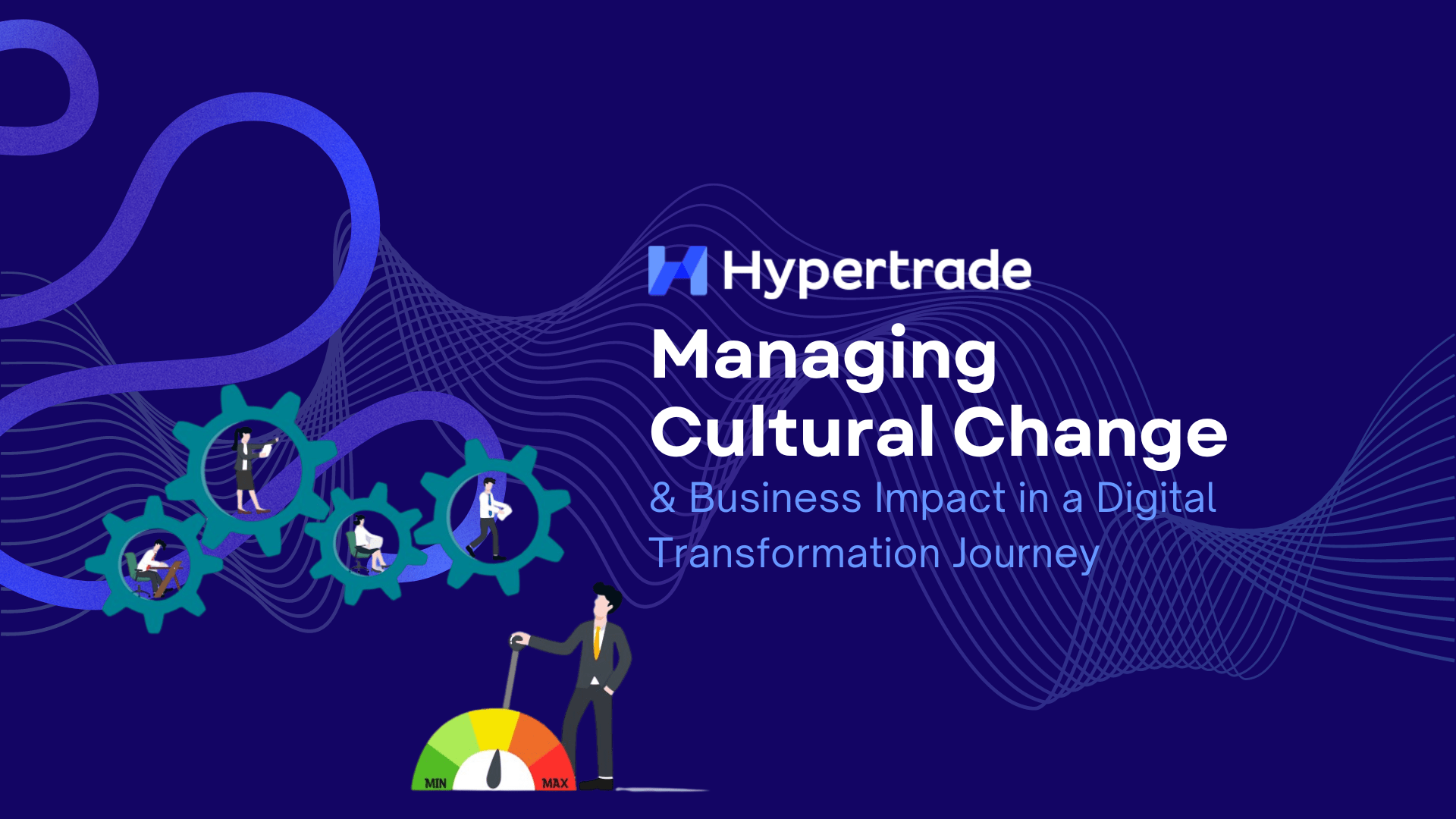In a recent article, Randy Bean was sharing on HBR that while investments in digitalization were poised to continue, most companies that invested (in a survey across Fortune 1000 companies) were harvesting very little of the expected results.
Randy then shares 4 main recommendations for companies that aspire to leverage data and analytics to transform their business: Focus on Cultural Change and its Business Impact; Start Small; Build Strong Partnerships and Don’t Forget About Data Ethics.
At Hypertrade, our job is to help medium-size – and often family- owned organizations leverage their data to transform their business. Therefore these 4 directions resonate strongly with what we do every day and the practical experiences and challenges our Teams have to address.
In this article, we want to focus on the Start Small and Focus on Cultural Change components. Yes, they do slow the project’s progress at its earliest stage, but the global buy-in and the transformation are stronger, delivering better and more sustainable results in the latest stages.
We are happy to bring our 5 cents sharing on some of the things we do – after failing and learning a few times – and that worked.
Cultural Change and Business Impact
Our experience tells us this is by far the most important success factor to be considered in a transformation project. While everyone seems to be aware of it, business agendas tend to neglect it as it is often perceived as an obstacle to a quick ROI. It’s going to take time and money; it will delay our ROI on technology investment are often heard. In reality, the time invested in driving Cultural Change and assessing Business Impact is a critical success factor.
Imagine a highly successful family business that grew over generations thanks to a visionary leadership, where each challenge was addressed and solved while maintaining a solid grip and control over business decisions and operations. Over time, some of the solutions found became bottlenecks, some of decisions processes that had been set up became brakes. When the Leadership perceives it is time to transform the organization, they are often aware about the changes it will require, but they also often underestimate the resistance to change they will face. Another factor that is also often overlooked is the Teams data literacy, and the appetite – or absence of – they might have towards data and technology tools.
In our practice, here are the activities we propose to our clients, when installing a merchandising, category management of CRM solution, to help their Teams throughout the transformation journey.
Key Process Mapping & Business Impact with Senior Management
The leverage of data will primarily impact 2 main business components: decision-making and communication. For each of them, it is important to identify:
- for the selected processes, what are the commonly perceived and identified bottlenecks?
- what impacts data and automation will generate on what already exists in terms of cultural values, time, costs, constituencies, and roles?
- what do we want to maintain? what do we want to change and why? How do we want to build the continuity and alignment with the values in place?
- what measurable results & gains are we targeting?
- what tangible benefits for the Teams and individuals in place?
Preliminary Key Processes Workshops with Teams
Before even training teams on the new tools, we organize workshops on existing business processes. in these workshops, we put on paper the unofficial decision-making to understand how things are getting done, what are the bypasses that are used. We also put a lot of importance in understanding where are the pains both perceived and experience by the teams.
The information we capture at this stage are then used in internal communication to not only sell the project, but also to capture feedback to improve and adjust the initial plan back with Senior Management.

Change Management Sessions
The Change Management Session are maybe the most important ones. They are also the most difficult. Their facilitation requires 3 mindsets: storytelling, selling, and planning. As in all workshops, the beginning sets the tone. We always begin with what already exists, with a probing approach (ie please confirm that our understanding is correct). And what already exists is:
- the existing process
- the existing pain points.
We then move to the selling part (what is in it for them, the Team, the Company, in this order) where we are careful to record the level of support.
We close with the planning part, where we will also ensure that we record all comments, suggestions and gauge the level enthusiasm.
Data Literacy Training
In order to ensure all teams, have a common level of understanding, we are taking 3 actions.
- organize data training which are linked to the working processes teams are performing. In our industry, for example, these will be short sessions on Assortment, Promotion, CRM or Distribution Management
- organize this knowledge in a wiki that me make available to all teams (HPT Pedia)
“Change In Motion” Sessions
For every new process working session, when we train about how a process is going to be done differently and supported by data (see Start Small ), we always follow the same workshop structure, building in what has been learned during the Key Processes workshop:
- what is the process all about.
- how it is being currently done.
- the pains and obstacles admittedly met.
- what are the pains and obstacle solving benefits the revised process will deliver?
- what are the key differences between the old way and the new way?
- what is the implementation plan?
We also make sure that enough time has been planned for the Transition. Giving it 2 or 3 months gives enough time with teams to become familiar with the process and the tool and have additional training sessions or refreshers when they require it.
Start Small
As a solution provider, we used to think that a project could be considered successful a few months after the complete setup of our solution. After all, our solutions are simple to use! Working predominantly in the retail industry, we therefore used to suggest a complete roll out across all categories and formats at once. Our rationale was that it was addressing the Client’s Senior Management who wanted it to be done quickly.
The results were almost always the same: only a few teams were really using data and they transformed their performances. But several other teams, people managing categories of a lesser importance, or related business units that were not directly concerned, had not been allocated enough time and efforts, and progressively lost interests.
We might have helped our client break data silos, saved time and helped capture business opportunities, but we did not help our client drive the complete transformation they had in mind.
Small… but connected
For a Start Small approach to be successful, we learned that it requires a clear definition of each of the following steps, the value each step will bring and their inter-dependencies. It sounds obvious, doesn’t it?
It is usually not too difficult for Teams to identify the several steps of change. What is more challenging, and requires reflection, is the order in which they would be best implemented. At least 5 factors need to be considered:
- easiness to do.
- level of potential resistance.
- identifiable and measurable gains when implemented.
- what impacts on other business processes?
- what other steps it enables to do
Because each organization is unique, the importance of each factor will vary. What we are certain of, however, is that by-passing this assessment and planning session does not accelerate the project.
Change Blocks
Once the steps planning is finalized, we are starting to build what we call Change Blocks. A Change Blocks is made of 3 main elements:
- A timeline that starts with the process mapping and ends with the beginning of the roll out.
- The change drivers (process mapping, change management and change in motion sessions. Data Literacy, training and roll out)
- The business characteristics of the process we want to change.
Each block must precisely detail what are the Change benefits for the Company, the Teams and the Individual
For each block, Business Processes, Data Literacy, Change Management (that include implementation plan) and Coaching sessions are estimated and planned. The communication and project management of the transformation becomes also much easier to visualize and comment.
A Change Block can be easily represented as a card (see below), and the Card put on a calendar.

This practical approach to change management has proven to be generating a better traction and support from our Clients’ Teams:
- a better visibility on why we are doing this and how this will happen.
- a justified feeling of being part of the change, with a role to play.
- an officialized “adaptation period” that decreases fear.
With continuous and permanent change, we are all directly or indirectly involved in change management projects. We are happy if you can share your thoughts and experiences with us!
Communicate: the first partnerships are internal
Keeping Teams informed and sharing information as openly and honestly as possible, from what is in it for them to how will this happen is maybe one of the biggest challenges. There is a set of populations where we pay a particular attention: the end-users. We want to help them build an awareness about the additional value they will bring thanks to the project.
In addition to the Change Management and Change in Motion sessions, we found that some additional media were quite useful: regular Newsletter, Leaderboards, as well as specific internal chat channels (we use Teams and love the “praise” function!) for example.
If the HR Team already runs these channels, it is great to embed the Project Communication into it. If not, they are easy to setup and a responsibility of the Project Management Teams.
We also love the solution WeGrow, which makes sharing field experiences and success fun and super-efficient.
“Effective communication is 20% what you know and 80% how you feel about what you know.”
Jim Rohn
Building on Rohn’s quote, heart (with solid planning!) might be one of the best drivers for change.
About the author
Frederic Klein is Hypertrade’s Operations Director and Frederic Etienbled is Hypertrade’s founder and CEO. With their Teams, they oversee the implementation and support of Hypertrade’s Merchandising, Category Management and Retail CRM solutions in South-East Asia, the Middle East and Africa. They both have prior extensive retail experiences. They can be reached at f.klein@hyper-trade.com and frederic.e@hyper-trade.com







